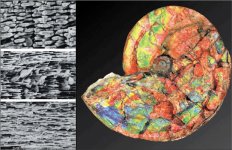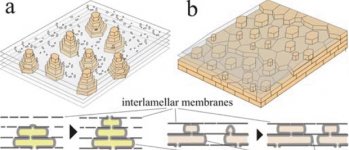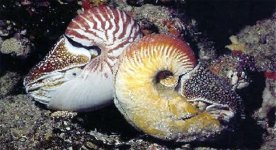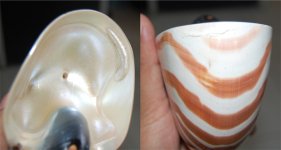You are using an out of date browser. It may not display this or other websites correctly.
You should upgrade or use an alternative browser.
You should upgrade or use an alternative browser.
Nautilus pearl
- Thread starter effisk
- Start date
claudenancy
New Member
- Joined
- Jul 2, 2008
- Messages
- 246
It is like having a front row seat as history is being made! Nautilus has to be one of the most elegant shapes in nature.
SteveM
Well-known member
- Joined
- Jan 29, 2007
- Messages
- 2,112
Tying some loose ends together today, and it seems a new avenue for exploration has presented itself…
Much earlier in the thread the discussion deviated to the precious gem ammolite—fossilized nacre from Nautilus' ancient ancestor, the ammonite. Down the thread, the complexity of the Nautilus shell has been explored, including the totally unique co-existence of columnar (gastropodian) and terraced (bivalvian) nacre microstructure.
It occurred to see what work had been done on ammolite microstructure, and a definitive paper on the subject came to light: Ammolite: Iridescent Fossilized Ammonite from Southern Alberta, Canada - By Keith A. Mychaluk, Alfred A. Levinson, and Russell L. Hall - Gems & Gemology, Vol. 37, No. 1, pp. 4 - 25 - Spring, 2001 - Gemological Institute of America.
This paper correlated the primary colors of ammolite with distinct microstructures, providing the SEM images below left. The most common ammolite color (and strongest material) is red, corresponding to the photo on the upper left showing columnar stacking of the aragonite platelets. The left-middle photo shows transitional, less ordered stacking, and corresponds to green. The lower left photo is the least ordered with the appearance of a brick-and-mortar, terraced nacre configuration, corresponding to the rarest (and most fragile) ammolite color, blue/purple.
While modern Nautilus shell microstructure research is cited by Michaluk/Levinson/Hall, it appears they were not aware of a 1995 paper by Mitchell and Phakey in Australia that first recognized the presence of terraced nacre in addition to the columnar that had long been considered the sole nacre type of Nautilus shells. Amazingly, the ammolite work independently confirms that this duality has been shared throughout the eons among shelled cephalopods. And accordingly, the rarest Nautilus nacre microstructure (terraced/bivalvian) corresponds with the rarest ammolite color (blue/purple).
Still, the location and distribution of the two types of nacre in the modern Nautilus shell is poorly understood. Dr. Antonio Checa at University of Granada is focusing his efforts on this aspect of Nautilus biominerality, unique to all mollusks.
I wonder if his answer might be color-coded…
(Photo on right from Antiques and the Arts.com, Bee Publishing Company, April 15, 2008.)
Much earlier in the thread the discussion deviated to the precious gem ammolite—fossilized nacre from Nautilus' ancient ancestor, the ammonite. Down the thread, the complexity of the Nautilus shell has been explored, including the totally unique co-existence of columnar (gastropodian) and terraced (bivalvian) nacre microstructure.
It occurred to see what work had been done on ammolite microstructure, and a definitive paper on the subject came to light: Ammolite: Iridescent Fossilized Ammonite from Southern Alberta, Canada - By Keith A. Mychaluk, Alfred A. Levinson, and Russell L. Hall - Gems & Gemology, Vol. 37, No. 1, pp. 4 - 25 - Spring, 2001 - Gemological Institute of America.
This paper correlated the primary colors of ammolite with distinct microstructures, providing the SEM images below left. The most common ammolite color (and strongest material) is red, corresponding to the photo on the upper left showing columnar stacking of the aragonite platelets. The left-middle photo shows transitional, less ordered stacking, and corresponds to green. The lower left photo is the least ordered with the appearance of a brick-and-mortar, terraced nacre configuration, corresponding to the rarest (and most fragile) ammolite color, blue/purple.
While modern Nautilus shell microstructure research is cited by Michaluk/Levinson/Hall, it appears they were not aware of a 1995 paper by Mitchell and Phakey in Australia that first recognized the presence of terraced nacre in addition to the columnar that had long been considered the sole nacre type of Nautilus shells. Amazingly, the ammolite work independently confirms that this duality has been shared throughout the eons among shelled cephalopods. And accordingly, the rarest Nautilus nacre microstructure (terraced/bivalvian) corresponds with the rarest ammolite color (blue/purple).
Still, the location and distribution of the two types of nacre in the modern Nautilus shell is poorly understood. Dr. Antonio Checa at University of Granada is focusing his efforts on this aspect of Nautilus biominerality, unique to all mollusks.
I wonder if his answer might be color-coded…
(Photo on right from Antiques and the Arts.com, Bee Publishing Company, April 15, 2008.)
Attachments
Last edited:
lisa c
Perpetual Pearl Student
Thanks for your ongoing research/reading. This is quite a treat!
These results aren't intuitive either. A columner wall is the least likely to be built because it's the least stable (for a bricklayer). There must be an inter-layer between the nacre layers - I guess that would correspond to the conchiolin(?) layer for pearls?yes? Does that layer persist in the ammolite?
Were any three dimensional images/diagrams provided? Time for me to look up the article, and quit bothering you, eh?
These results aren't intuitive either. A columner wall is the least likely to be built because it's the least stable (for a bricklayer). There must be an inter-layer between the nacre layers - I guess that would correspond to the conchiolin(?) layer for pearls?yes? Does that layer persist in the ammolite?
Were any three dimensional images/diagrams provided? Time for me to look up the article, and quit bothering you, eh?
Last edited:
SteveM
Well-known member
- Joined
- Jan 29, 2007
- Messages
- 2,112
For multi-dimensional diagrams of columnar vs terraced nacre there is a wide variety of scientific sources available.*Thanks for your ongoing research/reading. This is quite a treat!
These results aren't intuitive either. A columner wall is the least likely to be built because it's the least stable (for a bricklayer). There must be an inter-layer between the nacre layers - I guess that would correspond to the conchiolin(?) layer for pearls?yes? Does that layer persist in the ammolite?
Were any three dimensional images/diagrams provided? Time for me to look up the article, and quit bothering you, eh?
The organic interlamellar layers do not survive fossilization. Modern-day specimens, in order to be examined properly, are first prepared by dissolving away the organic material, so the images in my prior post are closely comparable to clean SEM images of contemporary nacre. The columnar type of nacre (gastropodian) is created similarly to terraced nacre but the lamellar pores are aligned rather than offset. The columns are so tightly stacked that it is certainly a strong structure. Recent research by Dr. Checa attributes columnar nacre to the need in gastropods to build nacre thickness quickly, as the animal (and its mantle) abandon the shell aperture when retreating into the shell for protection and the newly-secreted nacre must be able to immediately withstand the elements until the mollusk can return. Nautilus, being a single-shelled mollusk like gastropods, would have the same requirement although it does not retreat from the aperture nearly as much (witness the red/columnar ammolite at the ammonite aperture!).
Research pending publication suggests that Cephalopods (read: Nautiloids, Ammonites) were the first mollusks to evolve nacre, and it seems they developed and retained both types prior to independent, subsequent adaptation by bivalves and gastropods.
Nautilus fascination is all-consuming, and I have found myself in excellent international company as it is the focus of wide-ranging research, from the origin and continuity of complex life on earth, to modern medicine and engineering. There is still so much that is unknown…
…and all paths meet in the quest to discover and authenticate the mythical Nautilus pearl!
*Diagram below from a groundbreaking recent paper by Antonio Checa on a newly discovered aragonite microstructure, illustrating in comparison columnar gastropod nacre (a) and terraced bivalve nacre (b). Columnar nacre prioritizes thickness and fills in, terraced nacre grows in continuous horizontal layers. Both are composed of hexagonal aragonite platelets in a lamellar organic matrix, thus, nacre.
Attachments
Last edited:
Lagoon Island Pearls
Well-known member
- Joined
- Dec 8, 2009
- Messages
- 2,142
Columnar nacre prioritizes thickness and fills in...
Interesting stuff (yet again) Steve.
Something which stands out to me, is the notable absence of a periostracum. While some cephalopods have internal shells or pens and one species of cuttlefish (Sepia) has retained the septa, I can't help but wonder why. It sounds reasonable to suggest that columnar structure was indeed intended to alternatively build shell thickness rapidly in the absence of a "mold".
We know nothing of the soft tissues in fossils, though most scientists assume they were somewhat similar to those of Nautilus. Perhaps they're missing the point. Though highly speculative, perhaps the reason for Nautilus survival lies within one or more factors in the relationship between protein and calcium.
SteveM
Well-known member
- Joined
- Jan 29, 2007
- Messages
- 2,112
Below is a photo by Bruce Saunders of the two genera of Nautilidae, Nautilus and the very rare Allonautilus ('other' Nautilus). Allonautilus was established in 1997 by Saunders and Ward (yes, Peter Ward of University of Washington). Allonautilus scrobiculatus has a notable periostracum. As for Nautilus, the periostracum is reportedly more evident in juvenile animals and very thin, tattered membranes are found on mature animals.Something which stands out to me, is the notable absence of a periostracum.
Though highly speculative, perhaps the reason for Nautilus survival lies within one or more factors in the relationship between protein and calcium.
Re survival: This thread thrives on speculation—expound at will!
Attachments
Last edited:
Lagoon Island Pearls
Well-known member
- Joined
- Dec 8, 2009
- Messages
- 2,142
Below is a photo by Bruce Saunders of the two genera of Nautilidae, Nautilus and the very rare Allonautilus ('other' Nautilus). Allonautilus was established in 1997 by Saunders and Ward (yes, Peter Ward of University of Washington). Allonautilus scrobiculatus has a notable periostracum. As for Nautilus, the periostracum is reportedly more evident in juvenile animals and very thin, tattered membranes are found on mature animals.
How cool is that! Allonautilus is news to me, far post-dating any literature on my shelf.
Though several minor differences are evident, one thing that really jumps out at me, is the presence of considerable fouling. Surely a heavily laden animal would have difficulty in regulating bouyancy. The only Nautilus I've ever beheld were ornamental and as such were clean. Again, this makes me wonder if the periostracum itself is a factor in the species survival.
Have you observed this degree of fouling on Nautilus specimens?
SteveM
Well-known member
- Joined
- Jan 29, 2007
- Messages
- 2,112
Allonautilus periostracum was observed in live specimens for the first time in 1984, as beached versions had always been well cleaned after their time in the surf. A second species of Allonautilus, Perforatus, has yet to be observed live and is only known from its clean shells.How cool is that! Allonautilus is news to me, far post-dating any literature on my shelf.
Though several minor differences are evident, one thing that really jumps out at me, is the presence of considerable fouling. Surely a heavily laden animal would have difficulty in regulating bouyancy. The only Nautilus I've ever beheld were ornamental and as such were clean. Again, this makes me wonder if the periostracum itself is a factor in the species survival.
Have you observed this degree of fouling on Nautilus specimens?
The Allonautilus ('Crusty Nautilus') periostracum, as unappealing as it is, is regarded as genetic, not fouling. At the same time, Peter Ward would like to see more specimens, especially live-caught Perforatus.
There remains the matter of the surprising, unprecedented aragonite microstructure in the strange 'abominabilis' pearls. It may be necessary to consider Allonautilus in addition Nautilus as a possible source.
SteveM
Well-known member
- Joined
- Jan 29, 2007
- Messages
- 2,112
Returning to the thread title subject; a recently-acquired pearl, particularly well-shaped (10.02mm x 10.07mm, 7.3cts), chatoyant and with a clean, lustrous surface.There remains the matter of the surprising, unprecedented aragonite microstructure in the strange 'abominabilis' pearls.
Attachments
SteveM
Well-known member
- Joined
- Jan 29, 2007
- Messages
- 2,112
Here it is important to review the quote and the link contained within the quote. It takes us way back in the thread, and to a post that inferred nacreous shell swelling would indicate nacreous pearls.? the crack?coincides perfectly with the final septum wall juncture, and it seems clear that the additional nacre was produced to repair and reinforce the shell break.
This reminds me of this shell anomaly:
I've just noticed that the aperture in that Nautilus shell was neatly cut away to expose the nacre swelling. Source wanted an arm and a leg for it, not a smart thing to do. But it would be interesting to see the exterior of that shell to see what if any shell damage had occurred requiring reinforcement at that point.
I also wonder if this sort of provocation for deposition of new shell material would be considered as much a blister as the coating of an intruder or other shell wall irritant?
Just today I convinced that purveyor to show me the other side of the shell. He did admit cutting the shell, as he desired to expose the blister as the ultimate rarity in Nautilus shell deformation.
As I predicted, a crack coincides with the blister. So now we have five examples in this thread of a phenomenon not seen in Nautilus outside of Indonesia. Peter Ward believes he has an explanation but for the moment is allowing me (and PGers) to twist in the wind?
Attachments
GemGeek
Pearlista
Busy university professor, I guess. 
SteveM
Well-known member
- Joined
- Jan 29, 2007
- Messages
- 2,112
Busy is an understatement but my take is that Ward is really enjoying playing this out, cat vs. mouse. He wants to see what I can find out on my own. I envy his students.Busy university professor, I guess.
Have agreed to meet Peter in his office later this week to collect shells for SEM study in Granada early next month.
Lagoon Island Pearls
Well-known member
- Joined
- Dec 8, 2009
- Messages
- 2,142
As I predicted, a crack coincides with the blister. So now we have five examples in this thread of a phenomenon not seen in Nautilus outside of Indonesia. Peter Ward believes he has an explanation but for the moment is allowing me (and PGers) to twist in the wind…
This particular specimen appears to have had a collision or tumble at the age when the crack occured at the outermost margin of the aperture, where the shell is newly formed, thinner and weaker. Other than some bruising, the mantle remained healthy and continued to both form new shell and repair the crack. The thickness of the shell below the blister could bear this out.
This brings us to the scale-like structure of the blister itslef. Since it's been confirmed not be a parasite, it seems reasonable to assume it's a self-preservation mechanism.
If indeed that is the case, then it begs the question... why scaled and not smooth like bivalves?
Okay, here is where I go way out on a limb and answer my own question, with a theory which might also explain the spiral in nautilus pearls.
First an assertion. We all know cephalopods have highly complex sensory systems. Dexterious and agile tentacles, multiple suckers, chromataphores ... and so on.
That said, it's my submission, the mantle of nautlius does not excrete extrapallial fluid to all points uniformly and simultaneously, but instead from groups of cells in waves.
Liken it to browsing a Roladex, one card at a time, with sticky fingers.
SteveM
Well-known member
- Joined
- Jan 29, 2007
- Messages
- 2,112
Just to remind that this shell was cut and prepared to display the blister as it is the only such example the source has found (out of many thousands of shells sold) and he considers it a trophy piece. The 'blister' is not at the aperture but rather in the very same location as the others, at the base of the final septum on the outside shell wall, within the final body chamber. So the damage occurred years before the death of the animal, time to build such a thick shell reinforcement.This particular specimen appears to have had a collision or tumble at the age when the crack occured at the outermost margin of the aperture, where the shell is newly formed, thinner and weaker. Other than some bruising, the mantle remained healthy and continued to both form new shell and repair the crack. The thickness of the shell below the blister could bear this out.
This brings us to the scale-like structure of the blister itslef. Since it's been confirmed not be a parasite, it seems reasonable to assume it's a self-preservation mechanism.
If indeed that is the case, then it begs the question... why scaled and not smooth like bivalves?
Okay, here is where I go way out on a limb and answer my own question, with a theory which might also explain the spiral in nautilus pearls.
First an assertion. We all know cephalopods have highly complex sensory systems. Dexterious and agile tentacles, multiple suckers, chromataphores ... and so on.
That said, it's my submission, the mantle of nautlius does not excrete extrapallial fluid to all points uniformly and simultaneously, but instead from groups of cells in waves.
Liken it to browsing a Roladex, one card at a time, with sticky fingers.
Selective extrapallial excretion: Yes, something also tells me (if not biology, then the fossil record) that Nautilus has more control over this process than other molluscs.
As for spirals, HERE is a teaser, abstract of a letter to Nature by one of the pioneers of shell microstructure, Koji Wada, concerning his research into the spiral 'mounds' in calcitic (vs. aragonitic) mollusc shells. Unfortunately the actual paper provided by Nature upon purchase of the letter is a very poor quality scan.
Lagoon Island Pearls
Well-known member
- Joined
- Dec 8, 2009
- Messages
- 2,142
The 'blister' is not at the aperture but rather in the very same location as the others, at the base of the final septum on the outside shell wall, within the final body chamber. So the damage occurred years before the death of the animal, time to build such a thick shell reinforcement.
The blister didn't form perimortem. It was it was likely near the aperture at the time of cracking before the final septum was formed. The shell was repaired and the animal continued to grow normally. I'll read that link next.
SteveM
Well-known member
- Joined
- Jan 29, 2007
- Messages
- 2,112
The question (that Ward apparently has answered to his satisfaction) is why breakage always occurs in the same spot?forward of the final septum/exterior shell wall juncture. Each septum location is extremely precise, even pre-formation.The blister didn't form perimortem. It was likely near the aperture at the time of cracking before the final septum was formed.
Lagoon Island Pearls
Well-known member
- Joined
- Dec 8, 2009
- Messages
- 2,142
why breakage always occurs in the same spot—forward of the final septum/exterior shell wall juncture
The outermost edge of the aperture is the weakest point. Most anything crystalline chips at the weakest point... the edge. Even a minor bump on a hard surface can cause damage. Once healed, growth continues and the crack will no longer be at the edge.
I've obeserved this in bivalves often. By guaging the subsequent growth can tell which month of which year the crack occured.
We've also done the same with culturally modified trees. One cedar tree we found, was felled in 1849. How did we know this? Simple. Find a tree nearby which is larger, so that both might be estimated around the same age, as the fallen one no longer grows. Core both of them. Align the cores until the growth pattern matches. Then count the remaining rings on the living tree then subtract that number from the current year and you'll have your time of the felling.
GemGeek
Pearlista
Oooh! I'm so jealous that you get to learn from the master. 
SteveM
Well-known member
- Joined
- Jan 29, 2007
- Messages
- 2,112
OK, so today I met for the better part of an hour with Professor Ward. As he is one of the world's preeminent and pioneering astrobiologists I first asked him about the newly-discovered 'Goldilocks' planet Gliese 581g and he debunked it, saying his team can prove it's a dead gas giant, with no solid surfaces. (You heard it here first!!)I'm so jealous that you get to learn from the master.
Regarding the similarly-located cracks and blisters in our Nautilus shells from Indonesia, he is also quite confident. He took the shell we left to a colleague in structural engineering who had modeled the Nautilus shell previously. Their conclusion was that the damage occurred in the mature animal (upon completion of the final septum), and that the force required indicated rapid downward vertical movement. The shock energy would be concentrated just forward of the final septum (the first septum encountered) as shell strength after that point is greatly increased by the successive prior septa.
The only scenario imaginable for such forceful downward movement is surf, requiring the Nautilus to climb nearly to the surface, a highly unusual behavior. So a bit of a mystery, but well worth exploring, since the Nautilus populations of Indonesia are less studied than those of Micronesia and Melanesia.
A little wild imagination: As years were required to build the blisters, the cracking seems to coincide with the completion of the final septum, or very shortly after. As this event represents the biological 'coming of age' of Nautilus, could such drastic vertical climbing be some sort of ritual, mating or otherwise?
Ward has indicated that a scientific paper is in order, and we will deliver all of our shells to his care in the near future for proper documentation.
Similar threads
- Replies
- 99
- Views
- 17K
- Replies
- 2
- Views
- 2K





